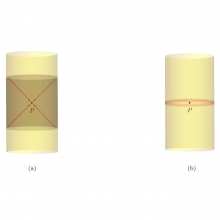A new study by ICTS members Chandramouli Chowdhury, Victor Godet and Suvrat Raju with Perimeter Institute for Theoretical Physics member Olga Papadoulaki, has discovered a unifying thread in two approaches to quantum gravity that were previously believed to be separate. The work was published in the Journal of High Energy Physics.
Finding a theory of quantum gravity - which would combine both quantum mechanical and gravitational effects - is one of the great unsolved problems of theoretical physics. Although no complete solution has been found, several distinct approaches to the subject have been adopted. More than 50 years ago, in 1967, Bryce DeWitt proposed that the theory should be governed by an equation, which is now called the Wheeler-DeWitt (WDW) equation. A different approach has dominated recent research. The so- called holographic principle that emerges from string theory suggests that the physics of gravity in a volume of space has an identical “dual” description that lives on its surface. A precise realization of this principle was found 25 years ago, in 1997, by Juan Maldacena, in a toy model of quantum gravity in a background called Anti-de Sitter space (AdS).
These two approaches to quantum gravity are often believed to be distinct. Some researchers believe that the holographic principle is a special property of string theory that may not behold in a realistic theory of quantum gravity. Others believe that the conventional approach that starts with the Wheeler-DeWitt equation has few insights to offer.
In the new work, the authors carefully studied solutions to the Wheeler-DeWitt equation in AdS. They found that solutions of the Wheeler-DeWitt equation have the surprising property that the entire solution is completely fixed by its form near the boundary of AdS. This leads to a version of the holographic principle since any question about the solution can be answered purely from boundary data. Therefore, the new study shows that, far from being distinct, the WDW equation directly implies a version of the holographic principle. Any theory of quantum gravity, not just string theory, must obey the WDW equation at low energies; so the new work suggests that all valid theories of quantum gravity must be holographic.
The new study also indicates that when both quantum mechanical and gravitational effects are important, information is localized very differently from our mundane conceptions. When the effects of quantum gravity are absent, it is possible to localize information in a finite volume of space in such a way that it is inaccessible to observers outside this volume. The new study suggests that this is intrinsically impossible in quantum gravity. The information always leaks out; observers who make sufficiently precise measurements surrounding a region of space, but always remaining outside the region, can, nevertheless, exactly decipher the information contained in that region.
The authors note this “dramatic difference between the storage of quantum information in quantum gravity compared to” ordinary theories is also important for understanding the evaporation of black holes due to quantum effects.
Image caption: AdS can be visualized as a cylinder with time running on the vertical axis. In ordinary theories (a) one needs information on the boundary for an extended time-interval to reconstruct physics at the central point P. The new study shows that, in a theory of quantum gravity, the physics in the middle of the space can be reconstructed from an infinitesimal part of the boundary (b).


